If you receive an error “There was a problem sending the command to the program” on Microsoft Word or Excel, the solutions provided in this article will help you. Usually, this error occurs while launching Microsoft Excel or Word applications, or opening an existing Word or Excel file. This error prevents users from editing or creating new documents.

There was a problem sending the command to the program
Use the following suggestions to fix the “There was a problem sending the command to the program” error in Excel or Word.

- Disable the Dynamic Data Exchange (DDE) feature
- Disable Add-Ins
- Delete a key in the Windows Registry
- Repair or reinstall Office
Below, we have explained all these fixes in detail.
1] Disable the Dynamic Data Exchange (DDE) feature
Windows provides several methods for transferring data between applications, Dynamic Data Exchange (DDE) protocol is one of them. The DDE protocol is a set of messages and guidelines. It sends messages between applications that share data and uses shared memory to exchange data between applications. The components inside Microsoft‘s productivity suite, i.e., Office, use the DDE protocol.

This fix is only for Microsoft Excel because the DDE feature is not available in Microsoft Word. Therefore, if you receive this error message in Microsoft Word, you can skip this fix. We suggest you disable the DDE protocol in Microsoft Excel and see if it works. The following instructions will guide you on this:
- Open Microsoft Excel.
- Go to File > Options.
- Now, select the Advanced category from the left side.
- Uncheck the “Ignore other applications that use Dynamic Data Exchange (DDE)” checkbox.
- Click OK to save the changes.
When the above-mentioned option is enabled in Excel, it ignores the DDE messages sent to it by other programs. Therefore, Excel ignores the DDE message that is sent to Excel by Windows Explorer. Hence, Excel does not open the file on which you double-click.
2] Disable Add-Ins
An installed add-in can also cause this type of problem. Sometimes, add-ins in Microsoft Office applications create a conflict and prevent the Office applications from functioning normally. You can troubleshoot this by disabling the installed add-ins.
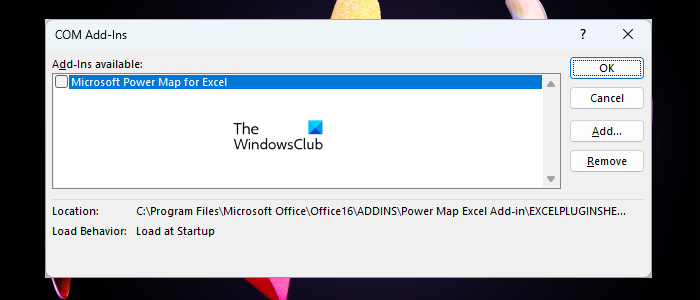
Follow the steps provided below:
- Open Microsoft Excel or Microsoft Word.
- Go to File > Options.
- Select Add-ins from the left side.
- Select COM Add-ins in the Manage drop-down on the right pane. Click Go.
- Uncheck an Add-in to disable it and click OK. Now, see if you can open the Excel file by pressing the Ctrl + O keys.
If the problem still persists, disable another add-in and then try opening the file again. Repeat this process until you find the culprit or disable all the add-ins. Once you find th culprit, look for its alternative.
3] Delete a key in the Windows Registry
Above, we have explained a method to disable the DDE feature in Microsoft Excel via the UI. If disabling DDE via the UI does not work for you, try the following method using Windows Registry. This method includes the modifications in the Windows Registry. Therefore, we recommend you create a System Restore Point and back up your Registry before proceeding. This will allow you to revert the changes if any problem occurs. Also, follow the steps carefully, as incorrect modifications in the Registry can make your system unstable.
Press the Win + R keys to launch the Run command box. Type regedit and click OK. Click Yes in the UAC prompt. This will open the Registry Editor.
Now, navigate to the following path.
HKEY_CLASSES_ROOT\Excel.Sheet.12\shell\Open\ddeexec
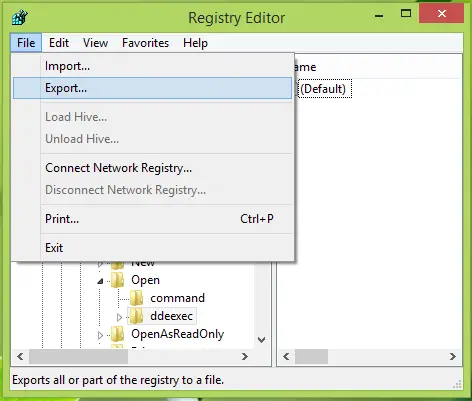
First of all, export the ddeexec key. Right-click on it and select Export. This will you to restore it by double-clicking on it.
After exporting it to a convenient place, you can right-click over the same key and select Delete:
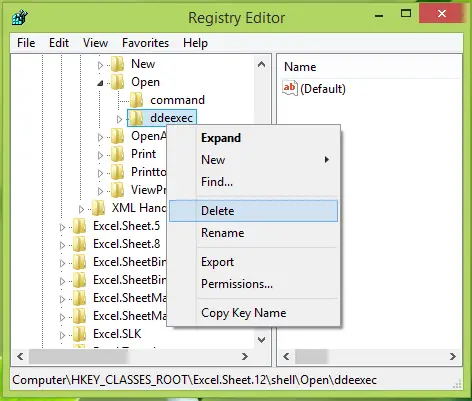
After deleting the key, you can close the Registry Editor. Restart your computer for the changes to take effect. After restarting your computer, the error should not occur.
4] Repair or reinstall Office
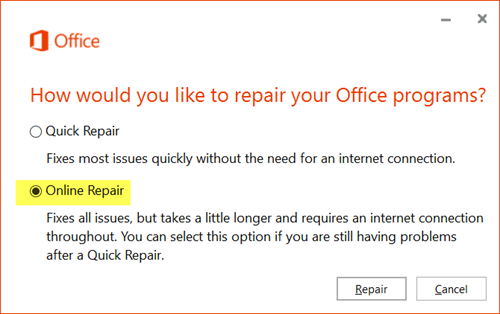
If the error still persists, might be the Office installation is corrupted, We suggest you repair your Office installation. Run an online repair and see if it helps.

If repairing Microsoft Office does not work, uninstalling and reinstalling Office can help. You can use the Microsoft Support and Recovery Assistant (SaRA) tool to completely uninstall Microsoft Office from your system. Before you uninstall Office, make sure that you have the product key because it will be required to reactive your Office license. If Microsoft Office is added to your Microsoft account, you can download it from there and install it on your system.
Microsoft Fix It
Microsoft has also released Fix It solutions to help resolve this issue:
- Windows 8 users may download Microsoft Fix it 20074.
- Windows 7, Windows Vista, Windows XP, Windows Server 2008, and Windows Server 2003 users may download Microsoft Fix it 50392.
- If you receive this error message while using Microsoft Excel, use Microsoft Fix It KB21149. It will Turn off the Ignore other applications that use Dynamic Data Exchange (DDE) setting.
If you face this problem when you click on any program shortcut, you might want to consider deleting the old shortcut and creating a new one in its place. This is known to work many times.
That’s it. I hope this helps.
How do I ignore other applications that use the DDE?
You can ignore the applications that use DDE in Microsoft Excel by enabling the Dynamic Data Exchange feature. Open Microsoft Excel and go to File > Options. Now, select the Advanced tab from the left side. Scroll down to the General section on the rightside and select the DDE checbox.
How do you fix Microsoft Excel is waiting for another application to complete an OLE?
If you receive the “Microsoft Excel is waiting for another application to complete an OLE action” error in Microsoft Excel, you can try soe fixes, like enabling the DDE feature, troubleshooting installed add-ins, etc. If one of the solutons work, you can uninstall and reinstall office.
Read next: This Workbook contains links to one or more external sources that could be unsafe.
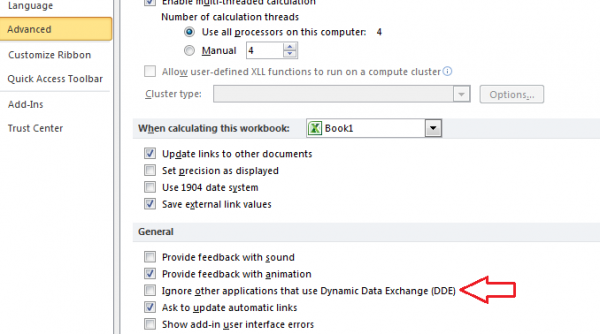
This doesn’t fix the problem.
The above solution is not helpful for VC++ applications.
I am working on a standard Visual C++ MFC application. There is a file say x.abc, whenver I double click this file, it opens directly in my VC++ app.
This VC app is running as administrator and that is the requirement of the project.
Case 1: Now, in Windows 7, when User Access Control (UAC) is ON, and I double click on file with .abc extenstion, it gives error message “There was a Problem sending the command to program” and the file doesn’t open and neither does that app.
Case 2: If my VC exe is already open and then I double click .abc file, it gives error “There was a Problem sending the command to program” and then the file opens.
This problem occurs in Windows 7 with UAC ON only.
Let me know if you have experienced the similar problem.
By the way, I am using the methods
EnableShellOpen();
RegisterShellFileTypes(FALSE);
VC++ User
For the excel option, unchecking the DDE box does fix this symptom, but causes a catastrophe of an issue, now I cannot open multiple excel instances. IE, no comparative side-by-side excel. This is not a fix, this is a break.
I’m not a programmer, but this work around works for me. When you see the above message, OK it and try clicking on the link again but this time with the Ctrl button held down. It’ll do the same thing again. But try it once more (click again with Ctrl held down) and it will take you to the linked program
.
Hopefully, this will give some programmer a clue to what is wrong and produce a real fix.
hi,
i just feel like to share what worked for me as this thing really annoyed me for several months.
i researched on several websites/sources and all the solutions i have come across do not work. such solutions include but are not limited to:
1) clearing of the checkbox of that DDE thing.
2) registry edit (too risky for non-savvy PC users like me)
3) unchecking of “run as administrator”
but just recently, i uninstalled a program called Tune Up utilities and then the annoying error was gone. so what i would suggest for others is to check which programs do you think are incompatible with your MS Office. then uninstall that (those) program (s).
hope that helps.
best,
filousophe
For excel 2013, this doesn’t fix issue, as addition, you should
edit open command, and replace suffix “/dde” to “/n “%1” /o “%u””,
then it would be work fine. you can check
https://gist.github.com/zencodex/b928ddb55ad6322ec960, and save it to
xxx.reg. I use chinese version excel, so you should edit xxx.reg, and
convert chinese charactors, double click xxx.reg will fix this issue.
NOTE: replace suffix “/dde” to “%1”, otherwise you coudn’t save excel. sorry for that. and I remove all chinese charactors, you wound’t convert. Have a nice day!
Every Autodesk worker offers new solution, some of them are really useless, like: drink coffee before you open file etc. Non of those solve the problem. It’s just another rubbish from Autodesk team to get profit. So frustrated with their products…
Thanks alot its worked
The second (regedit) fix didn’t work for me on Windows 7 64 bit, using Excel 2003. Now I right-click the downloaded xlsx file: “Open the containing folder” no longer functions.
The medicine seems worse than the sickness.
Thanks, worked for me. [Excel 2007]
wow, thank for helping. It’s helpfull.
This is the one. Spent 5 days on this, nothing worked. Thank you!
Microsoft: Office 2013 is more rubbish than Windows 8 was, and that’s saying something.
Whoops, posted at the wrong name – Zencodex’s fix is the one that fixed it.
This is the one. Spent 5 days on this, nothing worked. Thank you!
To Microsoft: Office 2013 is more rubbish than Windows 8 was, and that’s saying something.
I had the same problem and tried all the examples above and nothing helped.
What worked for me was removing my AVG PCTune-up program I installed a few weeks back. As soon as I removed it all my MS-Office products starting working fine without that annoying error message.
The strange thing is I did not have this issue when I installed the Tune-up program. Only after installing the latest Windows 10 updates. It appears that AVG does not come out with a new patch/update fast enough to keep up with Microsoft Windows 10 updates or Microsoft doesn’t take into account how their updates will affect AVG PCTune-up. Either way removing the AVG PCTune-up program instantly fixed my problem.